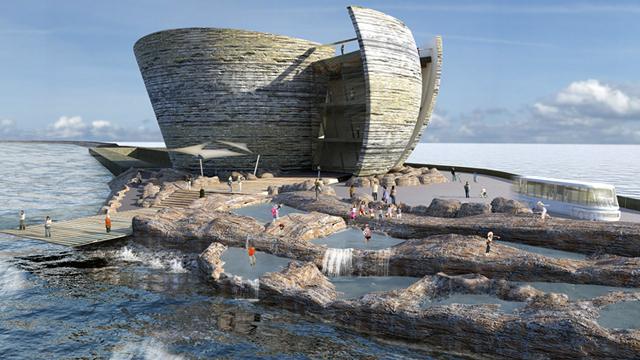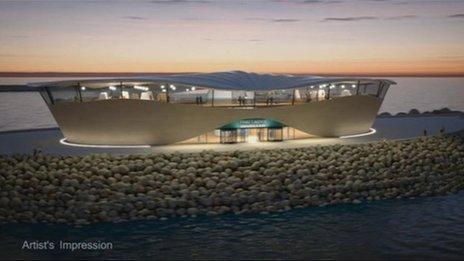£1bn Swansea Bay tidal lagoon 'game changer' hope
- Published

A six-mile long seawall would loop two miles out to sea
A £1bn tidal lagoon in Swansea Bay could be the launching pad for a new industry in Britain.
Tidal Lagoon Power (TLP) called the UK Government's decision to proceed a "game changer", with hopes already of five larger lagoons on the west coast of the UK.
Together they would contribute 8% of the UK's electricity and be worth £27bn to the UK economy by 2027.
But there are hopes the technology and know-how will be exported worldwide.
Mark Shorrock, chief executive of Tidal Lagoon Swansea Bay Plc, hailed the creation of a "Welsh powerhouse".
So what does this talk mean?
The backing by the Department of Energy and Climate Change (DECC) for the Swansea Bay project is about much more than generating green energy, even though that is significant in its own right.
It hopes that the world's first man-made lagoon built specifically to generate electricity will be the start of a new global industry for the UK with Wales at its heart.
If the lagoon is successful, it could be the springboard for Wales becoming a hub for turbine assembly, providing long term jobs.
The trade body for the renewable energy industry said at least half the contracts for Swansea would go to British companies.
Renewable UK's deputy chief executive Maf Smith, said: "This momentous news marks the start of an entirely new industry in Britain, which will lead the world in this innovative ultra-modern technology."
Mr Shorrock added: "The tidal lagoons that follow - at Cardiff, at Newport, elsewhere in the UK and overseas - must each make their own compelling social, environmental and economic case to proceed.
"But they have a pilot project to guide them and a blossoming technical and industrial network to support them."
BBC Wales environment correspondent Iolo ap Dafydd with the nuts and bolts of the tidal lagoon project - in 60 seconds
TLP still has to negotiate the guaranteed price for the electricity it will generate with the UK government and there are also environmental issues to be assessed.
If all goes to plan, work will start next March and the lagoon be ready in 2018.
It is generally accepted that the UK missed the opportunity to develop the technology behind onshore wind and as a result the most valuable parts of onshore wind farms are imported.
For months, David Cameron and George Osborne have spoken favourably of the Swansea lagoon in terms of kick-starting a new industry.
It is already included in plans by the UK Treasury, Welsh government and European Commission, all evidence that at least in economic terms TLP has been persuasive in its arguments.

Contracts have already been awarded
Swansea council said as well as 1,800 construction jobs worth £500m over three years to the local economy, the city region was in the right position to take its place on the world stage.
Council leader Rob Stewart said it would lead to a new industry "right on our doorstep that could potentially create a new export market in Swansea".
"Harnessing marine energy in this imaginative way could soon make Swansea a global example of innovative and sustainable best practice," he said.
The construction industry's training organisation CITB has also welcomed the decision, with TLP promising that 50% of the capital spending for the lagoon will stay in Wales and 65% in the UK.
The prospect of a new industry for Wales comes as the oil industry in Pembrokeshire has contracted, with Murco ending refining in Wales at the end of last year.
The hope of businesses like engineering firm Ledwood in Pembroke Dock is that they will now be able to help assemble the turbines and that many of the welders and fabricators who have lost work in the area can see a future in tidal energy.
- Published9 June 2015

- Published3 March 2015

- Published18 March 2015

- Published6 February 2015
